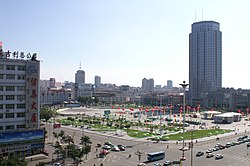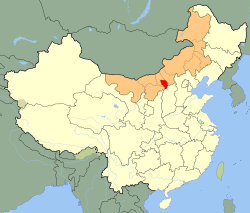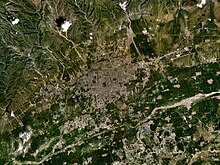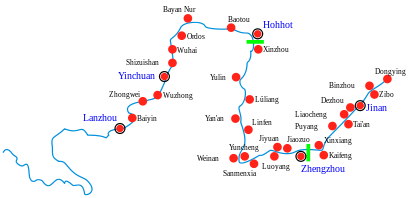Hohhot: Difference between revisions
m r2.7.3) (Robot: Adding simple:Hohhot |
m r2.7.2) (Robot: Modifying vi:Hô Hòa Hạo Đặc |
||
| Line 522: | Line 522: | ||
[[uk:Хух-Хото]] |
[[uk:Хух-Хото]] |
||
[[ug:Kökxot shehiri]] |
[[ug:Kökxot shehiri]] |
||
[[vi: |
[[vi:Hô Hòa Hạo Đặc]] |
||
[[war:Hohhot]] |
[[war:Hohhot]] |
||
[[zh-yue:呼和浩特]] |
[[zh-yue:呼和浩特]] |
||
Revision as of 19:35, 7 October 2012
Hohhot
| |
|---|---|
| City of Hohhot · 呼和浩特市 | |
 Hohhot Central Square | |
 Hohhot (red) in Inner Mongolia (orange) and China | |
| Country | People's Republic of China |
| Region | Inner Mongolia |
| County-level divisions | 10 |
| Township divisions | 116 |
| Established | 1580 |
| Government | |
| • CPC Committee Secretary | Han Zhiran (韩志然) |
| • Mayor | Tang Aijun (汤爱军) |
| Area | |
| • Prefecture-level city | 17,224 km2 (6,650 sq mi) |
| • Urban | 2,158 km2 (833 sq mi) |
| • Metro | 2,158 km2 (833 sq mi) |
| Elevation | 1,065 m (3,494 ft) |
| Population (2010 Census)[1] | |
| • Prefecture-level city | 2,866,615 |
| • Density | 170/km2 (430/sq mi) |
| • Urban | 1,980,774 |
| • Urban density | 920/km2 (2,400/sq mi) |
| • Metro | 1,980,774 |
| • Metro density | 920/km2 (2,400/sq mi) |
| • Major nationalities | Han - 87.16% Mongolian - 9.98% |
| Time zone | UTC+8 (China Standard Time) |
| Postal code | 010000 |
| Area code | 471 |
| License plate prefixes | 蒙A |
| GDP (2008) | CNY 131.6 billion |
| - per capita | CNY 51,016 |
| Local Dialect | Jin: Hohhot dialect |
| Administrative division code | 150100 |
| ISO 3166-2 | CN-15-01 |
| Website | http://www.huhhot.gov.cn/en/index.asp |
Template:Contains Chinese text
| Hohhot | |||||||||||
|---|---|---|---|---|---|---|---|---|---|---|---|
| Chinese | 呼和浩特 | ||||||||||
| Literal meaning | blue city or calling for peace, abundant, & unique | ||||||||||
| |||||||||||
Hohhot (Mongolian: ![]() , Chinese: 呼和浩特; pinyin: Hūhéhàotè, abbreviated Hū Shì (Chinese: 呼市); also romanized as Huhehot or Huhhot), is a city in north-central China and the capital of the Inner Mongolian Autonomous Region, serving as the region's administrative, economic, and cultural centre.
, Chinese: 呼和浩特; pinyin: Hūhéhàotè, abbreviated Hū Shì (Chinese: 呼市); also romanized as Huhehot or Huhhot), is a city in north-central China and the capital of the Inner Mongolian Autonomous Region, serving as the region's administrative, economic, and cultural centre.
The name of the city in Mongolian means "Blue City" — Kuku-Khoto in Mongolian - although it is also wrongly referred to as the "Green City."[2] The color blue in Mongolian culture is associated with the sky, eternity and purity; in Chinese, the name can be translated as Qīng Chéng (Chinese: 青城), literally, "Blue/Green City."[3]
History
The city was founded in 1581 by the Tumed Mongol ruler Altan Khan, in a marshy oasis on the steppes. The old city grew up around Buddhist temples and monasteries, some of which have been restored.[4]
Altan Khan and his successors constructed temples and fortress in 1579, 1602 and 1727. The Tümet Mongols had long been semiagricultural there. Hui merchants gathered north of the gate of the city's fortress, building a mosque in 1693.[5] Their descendants forms the nucleus of the modern Hui people's district.
In the 17th century, Han farmers began moving into the rich farmland around the city. After the Manchus founded the Qing Dynasty (1644-1911), the Kangxi emperor (reigned 1661-1722) sent troops to control the region.[6] The Qing Dynasty built a strong garrison town near Hohhot, supervising southwestern Inner Mongolia in 1735-39.[7] In 1913, the government of the new Republic of China united the garrison town and Hohhot as Guisi. With the occupation of the Japanese Empire in 1937, the city was renamed 'Hohhot'. After World War II, Prince Demchugdongrub's autonomous government in Hohhot surrendered to the Republic of China.
It was chosen as the region's administrative centre in 1952, replacing Ulanhot. Until 1954, Hohhot was referred to in Chinese as Guisui (歸綏 pinying: Guīsuī, Wade-Giles: Kweisui), which is the abbreviation of the two districts of the city Guihua (歸化, arch. Kwei-hwa): Southeastern old section, business district, established by Altan Khan around 1580, and Suiyuan (綏遠): Northeastern "New Town", government district, established in the 17th century by the Manchus. The two sections later became Guihua District (歸化縣) of the Qing Empire, renamed to Guisui County (歸綏縣) in 1913, and upgraded to a city in 1950. It was the capital of the now-defunct Suiyuan Province. In 1952, under Inner Mongolian chairman Ulanhu, the city became the capital of Inner Mongolia.[8] Suiyuan was annexed to the Inner Mongolian autonomous region two years later.
A city with a rich cultural background, Hohhot is known for its historical sites and temples and is one of the major tourist destinations of Inner Mongolia. It is also nationally known as the home of China's dairy giants Mengniu and Yili, and was declared "Dairy Capital of China" by the China Dairy Industry Association and the Dairy Association of China in 2005.
The city has seen significant development since China's reform and opening began. The city's far east side began development around 2000 and is now home to an artificial lake called Ruyi He, a large number of condominiums, the municipal government, and most of the Autonomous Region's government buildings. The Hohhot City Stadium was built on the city's north side.
Geography

Located in the south central part of Inner Mongolia, Hohhot is encircled by the Daqing Shan (大青山, lit. Great blue Mountains) to the north and the Hetao Plateau to the south.[9]
Climate
The city features a cold semi-arid climate (Köppen BSk), marked by long, cold and very dry winters, hot, somewhat humid summers, and strong winds, especially in spring. The coldest month is January, with a daily mean of −11.6 °C (11.1 °F), while the July, the hottest month, averages 22.6 °C (72.7 °F). The annual mean temperature is 6.73 °C (44.1 °F), and the annual precipitation is approximately 400 millimetres (15.7 in), with more than half of it falling in July and August alone. Hohhot is a popular destination for tourists during the summer months because of the nearby Zhaohe grasslands. More recently, due to desertification, the city sees sandstorms on almost an annual basis. Extreme temperatures have ranged from -30.5°C to 38.5 °C.
Climate
| Climate data for Hohhot (1971−2000) | |||||||||||||
|---|---|---|---|---|---|---|---|---|---|---|---|---|---|
| Month | Jan | Feb | Mar | Apr | May | Jun | Jul | Aug | Sep | Oct | Nov | Dec | Year |
| Mean daily maximum °C (°F) | −5 (23) |
−0.4 (31.3) |
7.0 (44.6) |
16.3 (61.3) |
23.2 (73.8) |
27.3 (81.1) |
28.5 (83.3) |
26.4 (79.5) |
21.2 (70.2) |
14.1 (57.4) |
4.4 (39.9) |
−3.2 (26.2) |
13.3 (56.0) |
| Mean daily minimum °C (°F) | −16.8 (1.8) |
−12.8 (9.0) |
−5.5 (22.1) |
1.6 (34.9) |
8.2 (46.8) |
13.3 (55.9) |
16.4 (61.5) |
14.8 (58.6) |
8.3 (46.9) |
1.0 (33.8) |
−7 (19.4) |
−14.2 (6.4) |
0.6 (33.1) |
| Average precipitation mm (inches) | 2.6 (0.10) |
5.2 (0.20) |
10.2 (0.40) |
13.5 (0.53) |
27.6 (1.09) |
47.2 (1.86) |
106.5 (4.19) |
109.1 (4.30) |
47.4 (1.87) |
20.7 (0.81) |
6.2 (0.24) |
1.8 (0.07) |
398.0 (15.67) |
| Average precipitation days (≥ 0.1 mm) | 2.5 | 2.8 | 3.4 | 3.7 | 6.0 | 8.9 | 12.9 | 12.7 | 8.3 | 4.5 | 2.4 | 1.8 | 69.9 |
| Average relative humidity (%) | 58 | 52 | 46 | 37 | 39 | 47 | 61 | 66 | 62 | 59 | 59 | 59 | 54 |
| Mean monthly sunshine hours | 180.7 | 198.3 | 245.5 | 268.6 | 294.5 | 291.3 | 264.9 | 255.2 | 252.1 | 244.8 | 195.3 | 171.0 | 2,862.2 |
| Source: China Meteorological Administration [10] | |||||||||||||
Subdivisions
The city is administratively at the prefecture-level, meaning that it administers both its urban area and the rural regions in its vicinity. The administrative area includes 4 counties, 4 districts, and a county-level banner; they are further divided into 20 urban sub-districts, and 96 townships. The data here represented is in km² and uses data from 2010 Census.
| Map | # | English Name | Simplified | Traditional | Pinyin | Area | Population | Density |
|---|---|---|---|---|---|---|---|---|

| ||||||||
| City Proper | ||||||||
| 1 | Huimin District | 回民区 | 回民區 | Huímín Qū | 175 | 394,555 | 2,255 | |
| 2 | Xincheng District | 新城区 | 新城區 | Xīnchéng Qū | 700 | 567,255 | 810 | |
| 3 | Yuquan District | 玉泉区 | 玉泉區 | Yùquán Qū | 270 | 383,365 | 1,420 | |
| 4 | Saihan District | 赛罕区 | 賽罕區 | Sàihǎn Qū | 1,013 | 635,599 | 627 | |
| Rural | ||||||||
| 5 | Togtoh County | 托克托县 | 托克托縣 | Tuōkètuō Xiàn | 1,417 | 200,840 | 142 | |
| 6 | Wuchuan County | 武川县 | 武川縣 | Wǔchuān Xiàn | 4,885 | 108,726 | 22 | |
| 7 | Horinger County | 和林格尔县 | 和林格爾縣 | Hélíngé'ěr Xiàn | 3,401 | 169,856 | 50 | |
| 8 | Qingshuihe County | 清水河县 | 清水河縣 | Qīngshuǐhé Xiàn | 2,859 | 93,887 | 33 | |
| 9 | Tumed Left Banner | 土默特左旗 | 土默特左旗 | Tǔmòtè Zuǒ Qí | 2,712 | 312,532 | 115 | |
Notable landmarks


There are over 50 sets of murals in southeastern Hohhot, including a "Horse-tending Image" (牧馬圖). Over 50 pre-modern Buddhist temples and towers.
- Tomb of Wang Zhaojun: Located to about nine kilometers to the south of the center of Hohhot. It is said to be the resting place of Wang Zhaojun, a commoner woman from the Chinese Han Empire who married a Xiongnu king, Chanyu.
- Temple of the Five Pagodas: Completed in 1732 with architecture very similar to that of Indian temples.[11] In its walls there are more than 1,500 figures of Buddha.
- Da Zhao Temple: A Buddhist monastery constructed in 1579, the oldest in the city.[12]
- Inner Mongolia Museum: Main exhibits include dinosaur fossils, historical artifacts of nomadic peoples, and the cultural life of modern nomadic peoples.
Culture and demographics
According to the 2010 Census, the population of Hohhot reached 2,866,615, counting 428,717 inhabitants more than in 2000 (the average annual demographic growth for the period 2000-2010 was of 1.63%).[13] Its built up area is home to 1,980,774 inhabitants (4 urban districts).
The majority of the population of Hohhot are Han Chinese, representing 87.16% of the total population in 2010. Most Han in Hohhot are descendants of people from Shanxi who have settled in the area over the past several decades, or those who have migrated from Northeastern China and Hebei province after the founding of the People's Republic of China in 1949, supported by government initiatives at the time to promote the development of border regions. Having been integrated into mainstream urban society, most Mongolians in the city speak fluent Mandarin Chinese in addition to Mongolian. However, younger speakers are moving towards speaking Mandarin amongst themselves as well. A significant portion of the population is of mixed ethnic origin.[14]
The majority of Hohhot residents can converse fluently in Mandarin, but there exists a linguistic divide between "old-town" folk (comprising today's Huimin District), with a large Muslim Hui minority, who tend to converse in raw Hohhot dialect, a branch of the Jin language from neighbouring Shanxi province. This spoken form can be difficult to understand for speakers of other Mandarin Chinese dialects. The newer residents, mostly concentrated in Xincheng and Saihan Districts, speak Hohhot-based Mandarin, the majority also with a noticeable accent and some unique vocabulary. (See Hohhot dialect for further details)
Due to its relatively diverse cultural make-up, and despite its characteristics as a mid-sized Chinese industrial city, the Hohhot street scene has no shortage of ethnic minority elements. Tongdao Road, a major street in the old town area, is decorated with Islamic and Mongol exterior designs on all its buildings. A series of government initiatives in recent years have emphasized Hohhot's identity with ethnic minority groups, especially in increasing Mongolian-themed architecture around the city. All street signs as well as public transportation announcements are regulated to be in both Chinese and Mongolian.
Food specialty in the area is mostly focused on Mongolian cuisine and dairy products. Commercially, Hohhot is known for being the base of nationally renowned dairy giants Yili and Mengniu. The Mongolian drink suutei tsai ("naicha" 奶茶 in Chinese, "milk tea" in English), which has become a typical breakfast selection for anyone living or visiting the city.[11] The city also has rich traditions in the making of hot pot and shaomai. There is also a large selection of Korean and Muslim restaurants, in addition to cuisine from other regions of China.
Ethnic groups in Hohhot, according to the 2000 census, were:
| Ethnicity | Population | Percentage |
|---|---|---|
| Han Chinese | 2,115,888 | 88.42% |
| Mongol | 204,846 | 8.56% |
| Hui Chinese | 38,417 | 1.61% |
| Manchu | 26,439 | 1.10% |
| Daur | 2,663 | 0.11% |
| Korean | 1,246 | 0.05% |
| Miao | 443 | 0.02% |
Transportation


Hohhot lies on the Jingbao Railway from Beijing to Baotou, and is served by two railway stations: Hohhot Station and Hohhot East Station.[15] Trains to Beijing link to destinations to the south and the northeast. The most prominent rail link with Beijing is the overnight K90 train, which has served the Hohhot-Beijing line since the 1980s and is referred to colloquially as the "9-0". Westbound trains go through Baotou and Lanzhou. There are also rail links to most major Inner Mongolian cities and to Ulaanbaatar. Because the quickest trip from Beijing takes around eight and a half hours despite the close distance of the cities, plans for high-speed rail has been discussed for years, and construction of the new high speed railway station began in 2008. The station was completed in 2011 and services 4 slow speed lines, with the high speed lines slated for opening sometime in 2013.
Hohhot's Baita International Airport (IATA:HET) is about 8km from the city centre by car. It has direct flights to Beijing, Shanghai, Shenzhen, Chengdu, Wuhan, Hong Kong etc., and to Ulaanbaatar, Mongolia. Long distance buses connect Hohhot to outlying counties, the cities of Baotou, Wuhai, Ordos, and other areas in Inner Mongolia.
The city's public transit system is composed of nearly one hundred bus routes and a large fleet of taxicabs, which are normally green or blue. The bus fare is 1 yuan. The taxi fare begins at 6 yuan.

Hohhot's major north-south thoroughfares are called "Lu" and its east-west thoroughfares are called "Jie". This is roughly equivalent to dividing roads into "street" and "avenue" designation according to direction, a practice used in some North American cities. The largest elevated interchange is near the site of the city's Drum Tower, after which it is named. Several major streets are named after Inner Mongolian leagues; among these, Hulun Buir, Xilin Gol and Xing'an run north-south, while Ulan Chaab runs east-west.
An expressway built in 1997 links Hohhot with Baotou, then known as the Hubao Expressway. In recent years this expressway has been expanded eastwards to Ulaan Chab and Zhangjiakou, and onto Beijing as part of the Jingzang Expressway. The city is en route of China National Highway 110, which runs from Yinchuan to Beijing. China National Highway 209 begins in Hohhot and is southbound towards southern China, with its southern terminus in Guangxi. Hohhot is connected to its northern counties through the Huwu Highway, which was completed in 2006. Previously travel to the northern counties consisted of lengthy navigation through mountainous terrain.
Education

Universities located in Hohhot include:
- Inner Mongolia University
- Inner Mongolia University of Agriculture
- Inner Mongolia Normal University
- Inner Mongolia University of Technology
- Inner Mongolia College of Medicine
- Inner Mongolia College of Finance and Economics
- Hohhot College of Education
- Hohhot College of Police
- Honder College of Inner Mongolia Normal University
High Schools located in Hohhot include:
Sister cities
Footnotes
- ^ "呼和浩特市2010年第六次全国人口普查主要数据(Sixth National Population Census of the People's Republic of China)". 内蒙古新闻网. Retrieved 30 August 2012.
- ^ Perkins (1999), p. 212.
- ^ Chinese "qing" has traditionally been a color between "blue" and "green" in English, leading some modern sources to translate Qing Cheng into English as "Green City" instead of "Blue City," including, for example, the official website of Hohhot.
- ^ Perkins (1999), p. 212.
- ^ Zhang, Guanglin (2005). Islam in China. 五洲传播出版社. p. 75. ISBN 978-7-5085-0802-3. Retrieved 29 August 2012.
- ^ Perkins (1999), p. 212.
- ^ Traditional dwellings and settlements review: journal of the International Association for the Study of Traditional Environments. International Association for the Study of Traditional Environments. 1998. p. 12. Retrieved 29 August 2012.
- ^ Leffman, David; Lewis, Simon; Atiyah, Jeremy (1 May 2003). Rough Guide to China. Rough Guides. p. 993. ISBN 978-1-84353-019-0. Retrieved 29 August 2012.
- ^ Encyclopedia Americana. Grolier Incorporated. April 2001. p. 510. ISBN 978-0-7172-0134-1. Retrieved 29 August 2012.
- ^ "中国地面国际交换站气候标准值月值数据集(1971-2000年)" (in Simplified Chinese). China Meteorological Administration. Retrieved 2009-03-17.
- ^ a b Lonely Planet. Níngxià and Inner Mongolia – Guidebook Chapter. Lonely Planet. p. 25. ISBN 978-1-74321-265-3. Retrieved 29 August 2012.
- ^ 大召寺Template:Zh icon
- ^ Template:Zh icon Compilation by LianXin website. Data from the Sixth National Population Census of the People's Republic of China
- ^ Official population data classifies mixed individuals as belonging to a single ethnicity. People with mixed Han and minority origin usually identify themselves legally as belonging to the minority. As a result, minorities may be overrepresented in the statistics.
- ^ Zhongguo dui wai jing ji mao yi nian jian bian ji wei yuan hui (1993). Almanac of China's foreign economic relations and trade. Hua run mao yi zi xun you xian gong si. p. 945. Retrieved 29 August 2012.
References
- Perkins (1999). Encyclopedia of China: The Essential Reference to China, Its History and Culture. Dorothy Perkins. 1st paperback edition: 2000. A Roundtable Press Book, New York, N.Y. ISBN 0-8160-4374-4 (pbk).
External links
![]() Media related to Hohhot at Wikimedia Commons
Media related to Hohhot at Wikimedia Commons
- Hohhot government website
- Transclusion error: {{En}} is only for use in File namespace. Use {{langx|en}} or {{in lang|en}} instead.Official website
- Template:Wikitravel

